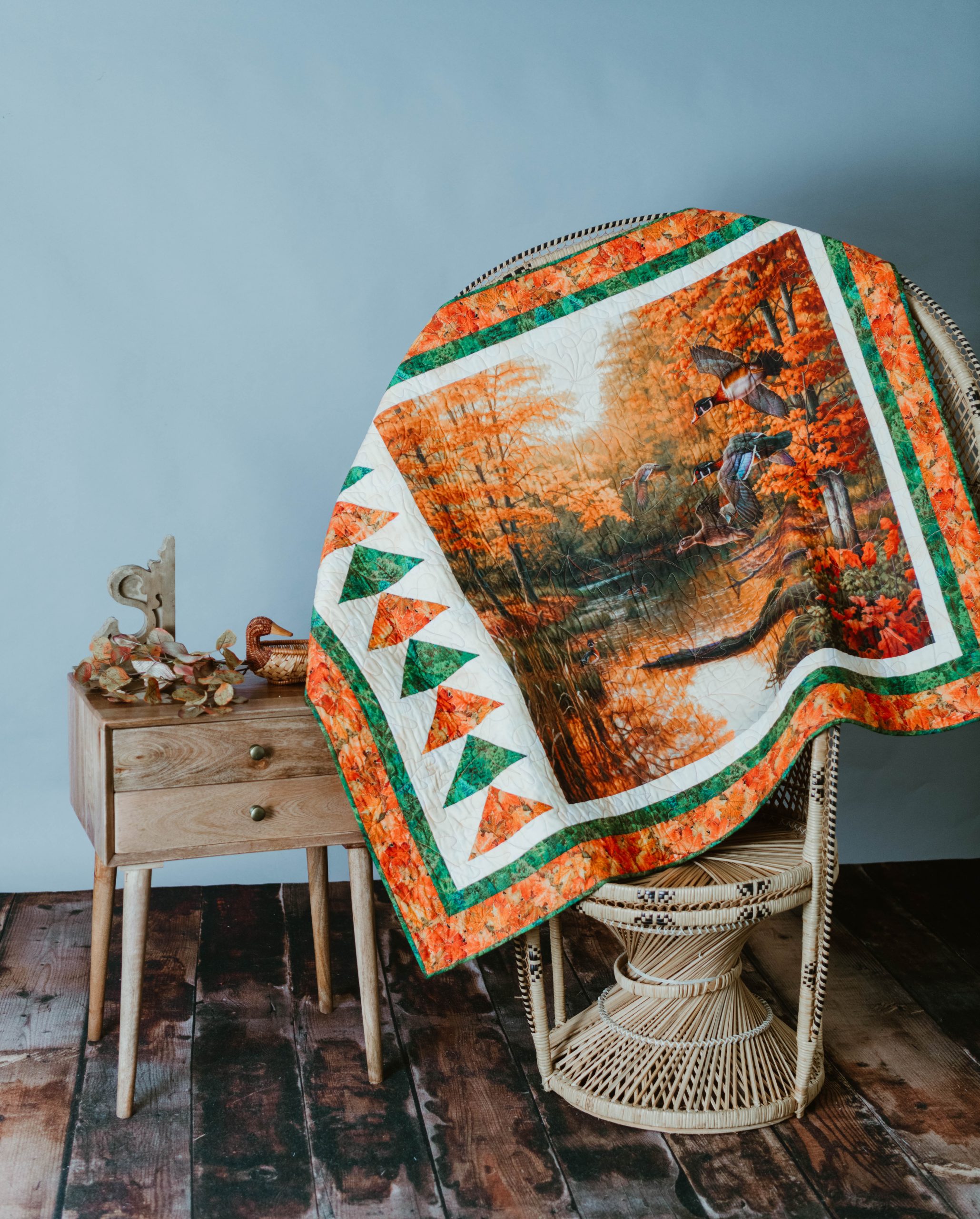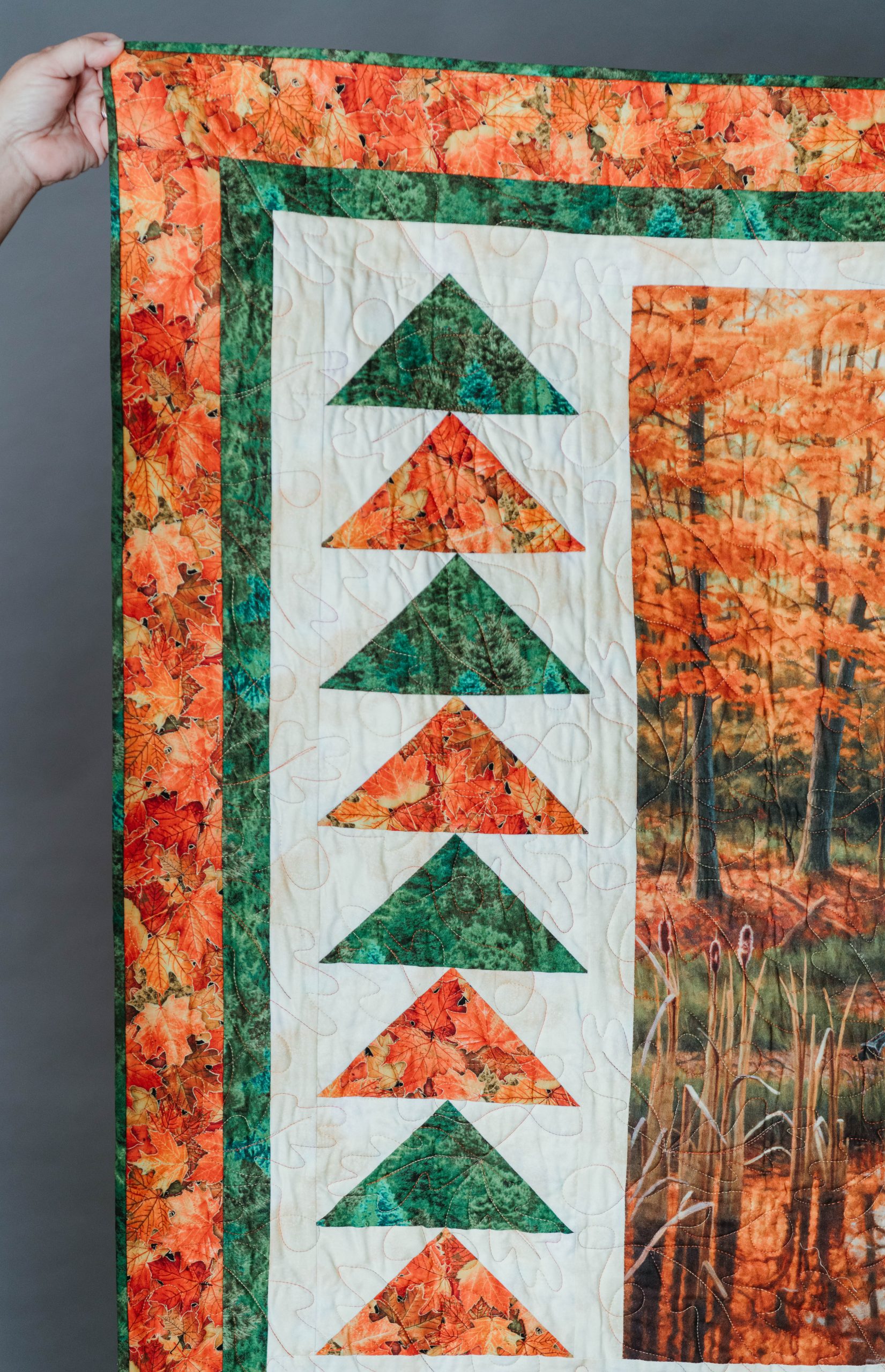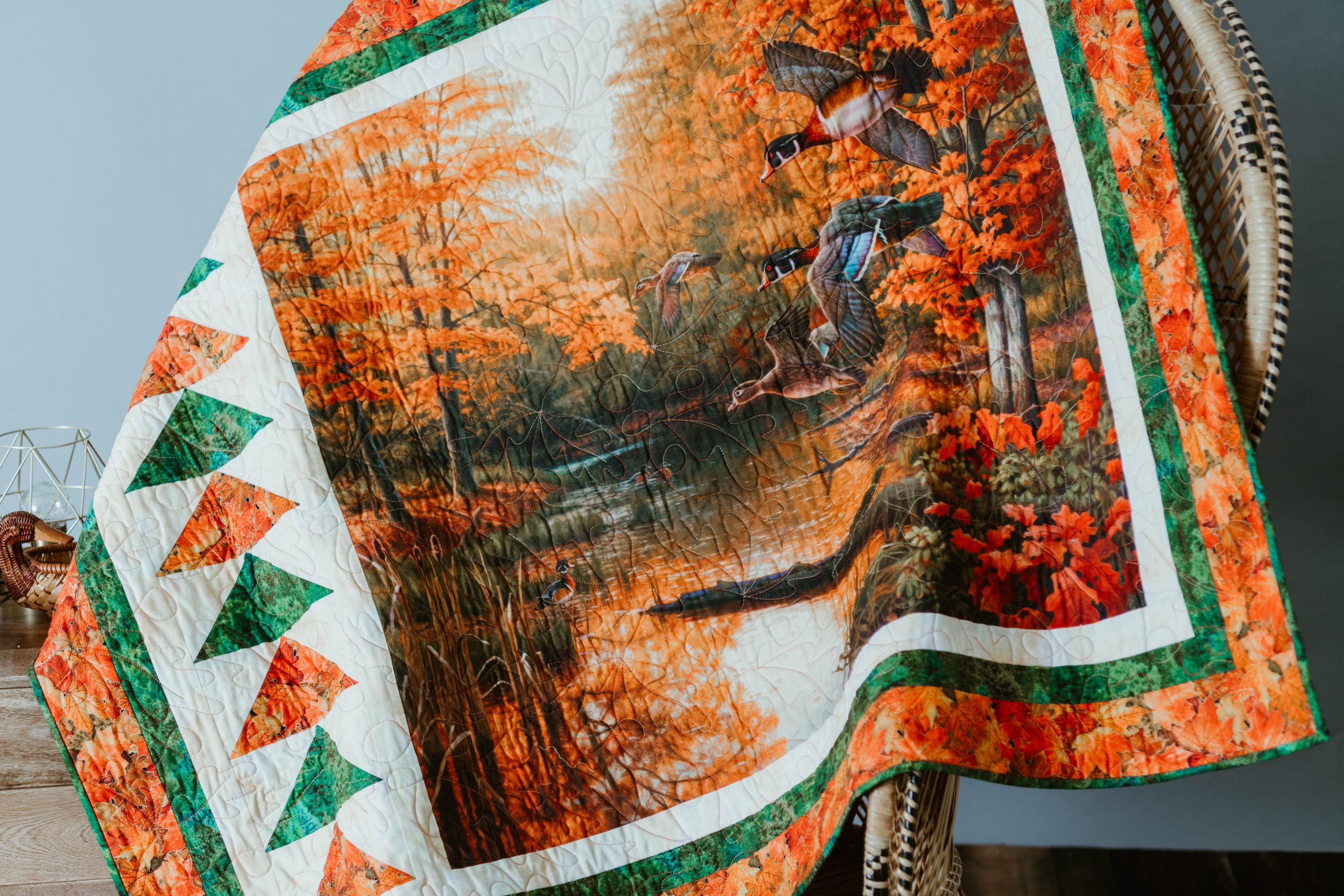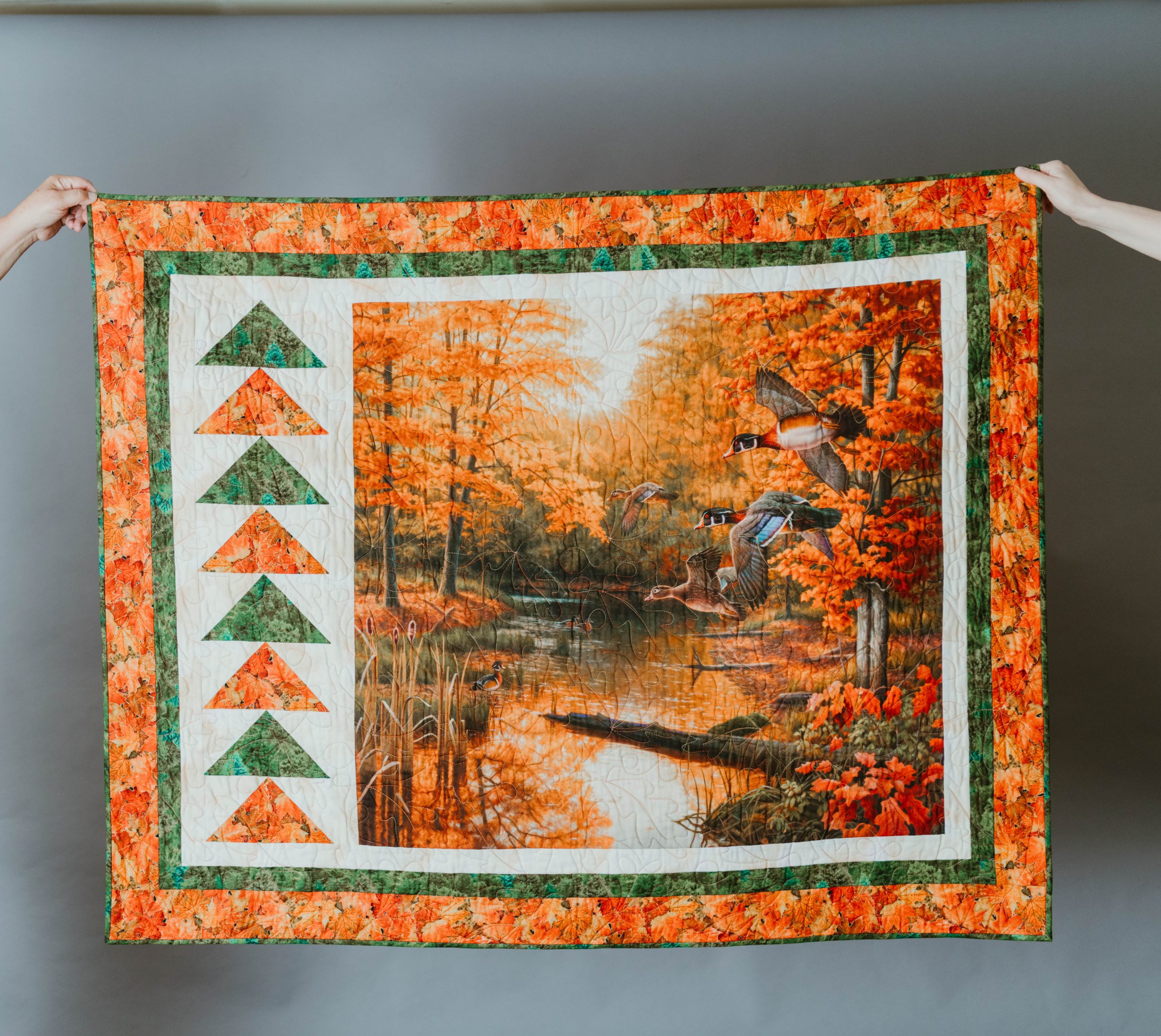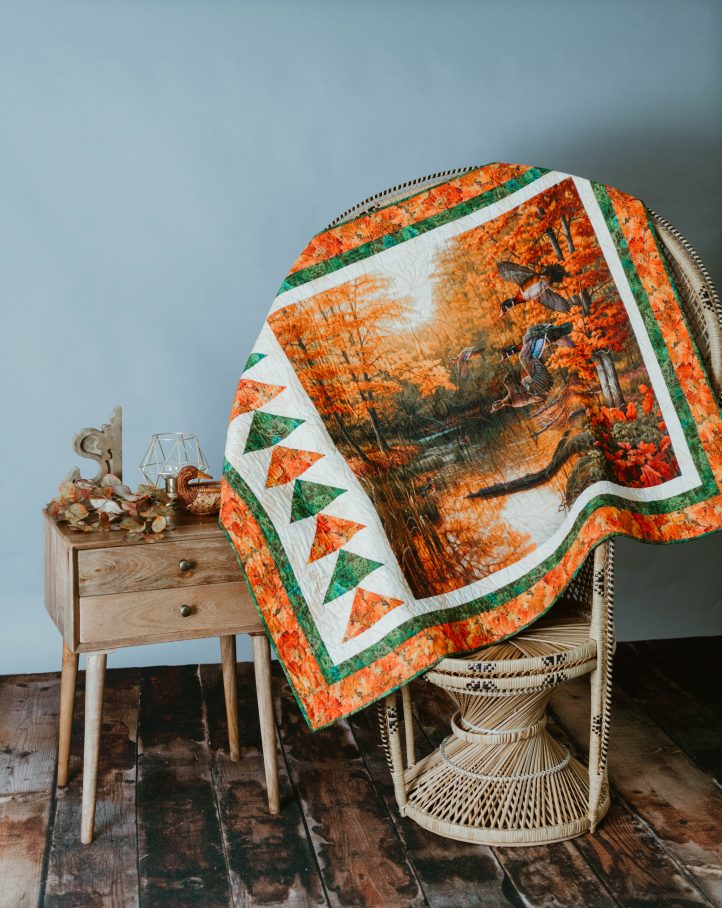
Design a gorgeous panel quilt that embodies the beauty of autumn woodlands with this pattern from Brenda Plaster. Measuring at 56” x 44 1/2”, this panel quilt pattern features a beautiful scene of ducks flying across a peaceful river with rich fall foliage and is completed with the addition of coordinating flying geese blocks. If you’ve been saving up a detailed fabric panel for the right quilt pattern, you’ll love this large throw quilt design.
Finished Size: 56” x 44-1/2”
Designer Note: Please read pattern before starting your project.
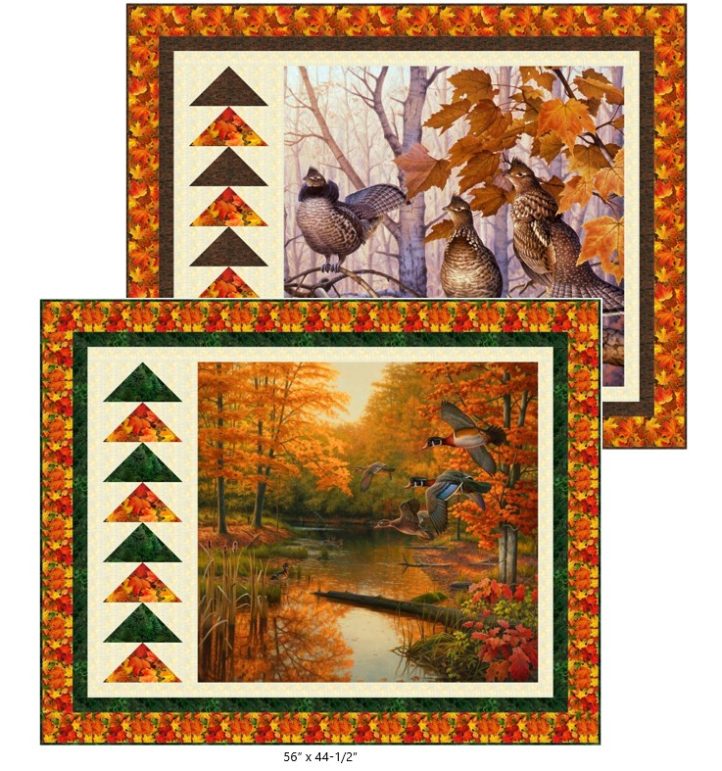
ADDITIONAL COLORWAYS:
The designer has provided fabric information for the sample shown, as well as additional colorways as inspiration for our readers!
Fabric from Magical Season collection by Elizabeth’s Studio
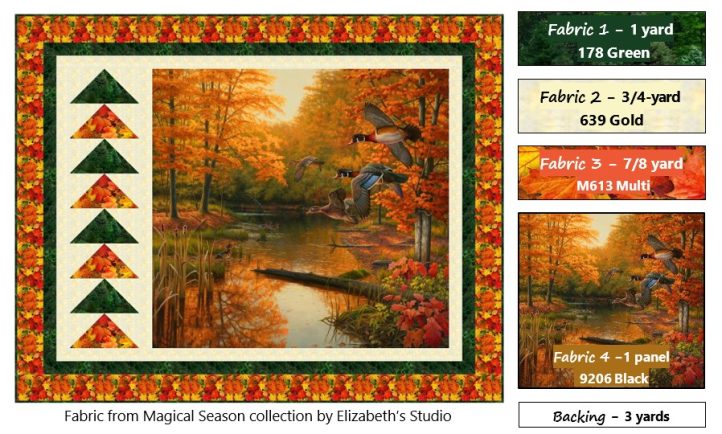
Fabric from Out on a Limb collection by Elizabeth’s Studio
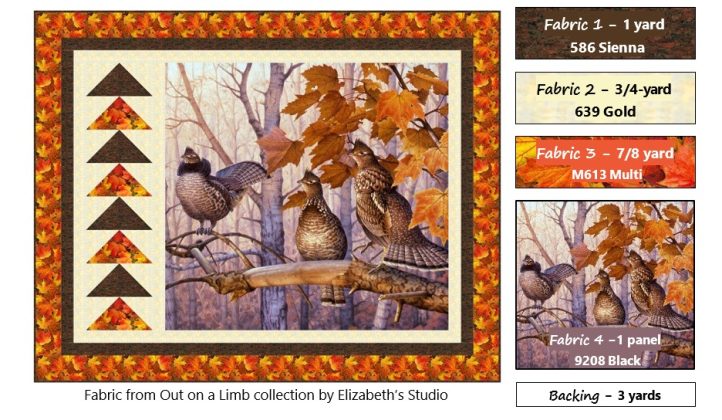
PATCH SUMMARY:
Note: Do not cut from this summary; see Fabric Requirements and Cuts. Patch descriptions refer to fabric pieces cut to construct patches, not the finished patch sizes.

A: 8-1/2” x 4-1/2” rectangle: 4 A1, 4 A3
B: 4-1/2” square: 16 B2
C (panel): 34-1/2” x 42-1/2” rectangle*(See note below) : 1 C4
D (sash between panel and flying geese): 2” x 32-1/2” rectangle: 1 sash
Fabric estimates are based on useable fabric width (selvage to selvage) of at least 42”. Add yardage if you prewash your fabrics or are fussy-cutting.
All cuts are across the fabric width, indicated as WOF (width of fabric). If you’re cutting from longer fabric pieces than the pattern indicates, consider cutting borders lengthwise of fabric. This avoids distortion and wavy borders, as fabric does not stretch on the lengthwise grain. (Cuts are WOF in this pattern to save fabric.)
In the patch labels (see Patch Summary), the letter refers to the patch. The number refers to the fabric from which it is cut. For example, A1 is an A patch cut from Fabric 1.
*Note: The width of C (the panel/large scale fabric) can be more or less than stated in the pattern; adjust the remaining patches to accommodate the difference. But the length needs to be that of the flying geese vertical row (see Step 2) in order to align with it.
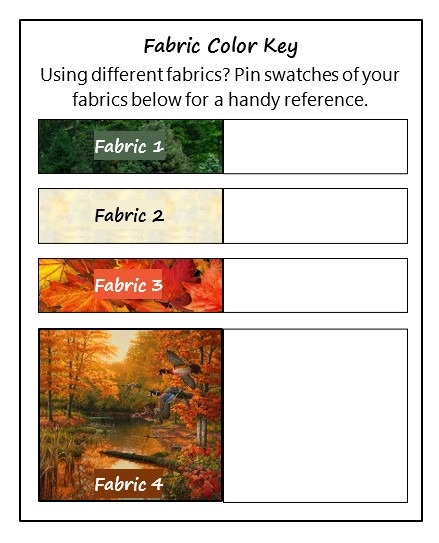
Fabric Requirements and Cuts:
- Fabric 1: 1 yard
- A1: Cut WOF [1] 4-1/2” strip.
- From this, cut [4] 4-1/2” x 8-1/2” rectangles.
- Middle border: Cut WOF [5] 2” strips.
- Binding: From remaining fabric, cut enough 2-1/4” or 2-1/2” (your preference) bias or straight of grain strips to join and make about 210” binding.
- A1: Cut WOF [1] 4-1/2” strip.
- Fabric 2: 3/4 yard
- B2: Cut WOF [2] 4-1/2” strips.
- From these, cut [16] 4-1/2” x 4-1/2” squares.
- D2 (sashing): Cut WOF [1] 2” strip.
- Inner border: Cut WOF [4] 2” strips if sewing straight border seams, 5 if sewing bias border seams.
- B2: Cut WOF [2] 4-1/2” strips.
- Fabric 3: 7/8 yard
- A3: Cut WOF [1] 4-1/2” strip.
- From this, cut [4] 4-1/2” x 8-1/2” rectangles.
- Outer border: Cut WOF [5] 3-1/2” strips if sewing straight border seams, 6 if sewing bias border seams.
- A3: Cut WOF [1] 4-1/2” strip.
- Fabric 4: 1 panel OR 1 yard
- C4: Fussy-cut panel or large scale print fabric to size needed (see *Note and Step 2). Remember you will lose 1/4” of the image on all sides in the seams.
- Backing: 3 yards
- Backing 4” larger on all sides than the quilt top is recommended for longarm quilting (64” x 52-1/2”). Cut fabric into two equal lengths and join to make an 83-1/2” x 54” backing. (Width will be more if fabric is more than 42” wide.) Remove selvage before sewing seam to prevent puckering.
Piecing Instructions:
All seams are 1/4”. Press seams as indicated in instructions or illustrations. Or there’s the option of pressing seams open.
- Draw a diagonal line on wrong side of 4-1/2” Fabric 2 squares. Place right sides down on sides of 8-1/2” x 4-1/2” Fabrics 1 and 3 rectangles, aligning outer edges and orienting stitch lines as shown. Stitch on drawn line.* Cut away excess fabric, leaving a 1/4” seam. Sew 4 of each.

- Note: Hate to waste the trimmed triangles? Draw a line 1/2” from the center diagonal line drawn on the squares. Sew on that line. Cut between these lines, leaving a 1/4” seam on each unit. You’ll have HST squares you can use in another project.
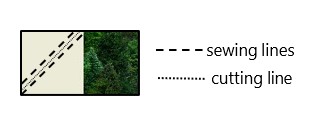
- Note: Hate to waste the trimmed triangles? Draw a line 1/2” from the center diagonal line drawn on the squares. Sew on that line. Cut between these lines, leaving a 1/4” seam on each unit. You’ll have HST squares you can use in another project.
- Combine the flying geese units made in Step 1 as shown below. Press seams toward top of unit or open. Measure unit lengthwise. Cut C (panel), D (sash) and 2 inner border strips to that length. Join units as shown. Press seams toward sashing/border.
- Measure width of quilt. Cut 2 inner border strips to this length. Sew to quilt top and bottom.

- Measure through quilt center lengthwise. Cut 2 middle border strips to this length. Sew to quilt sides. Measure width of quilt. Cut 2 middle border strips to this length. Sew to quilt top and bottom. Add outer border in the same way. Press seams toward borders.
- Layer top, batting and backing. Quilt as desired. Bind quilt with Fabric 1 binding strip.
This pattern was tested by Jacci Schumaker. Thank you!

